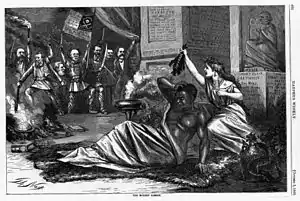The Modern Samson
The Modern Samson is an influential political cartoon drawn by cartoonist Thomas Nast. It originally appeared on Page 632 of the October 3rd Issue of Harper's Weekly in 1868.[1]

Details
The first Reconstruction Act was in March 1867; one of the stipulations for the eleven former Confederate states to regain Congressional representation in the union was the requirement of black manhood suffrage. Three states would not conform until 1870 when the Fifteenth Amendment constitutionally required them to comply.
The Modern Samson is a parody of the biblical story of Samson, and implies that voting rights (shown as Samson's hair) is a strength of black men that the opposing Democrats (shown as Delilah) strive to keep them from. Nast shared the views of the Republicans who considered equality in politics to be integral in economic and cultural advancement.[2]
The caricatures of armed Democratic figures include (from left to right): Wade Hampton III with a torch held high; Nathan Bedford Forrest with a Fort Pillow Medallion; Robert E. Lee squatting; presidential nominee Horatio Seymour with hair shaped into horns, wearing a Ku Klux Klan breastplate, and carrying a flag that promotes slavery, the "lost cause" (the Confederacy), American Civil War draft riots of New York City, the Ku Klux Klan, and the Reconstruction race riots in Memphis and New Orleans; wearing another Ku Klux Klan breastplate, former Confederate Rear Admiral Raphael Semmes; and 23rd New York Governor John Hoffman with a generic Catholic Irish-American under his arm. On the far right, a statue of President Andrew Johnson is likened to a "Moses" of the black Americans holding a tablet labeled "veto" to remind the audience of his recent Reconstruction legislation veto. Under the statue is a snake with horns similar to the hair of the depiction of Seymour, alluding to Satan. Opposite, on the left, a bonfire is depicted in front of them burning the Bible as well as various symbols of knowledge including books, a scroll, and a globe.[2]
References
- "Image from HIUS 202". Cti.itc.virginia.edu. Retrieved 2012-05-09.
- "HarpWeek | Elections | 1868 Medium Cartoons". Elections.harpweek.com. Retrieved 2012-05-09.